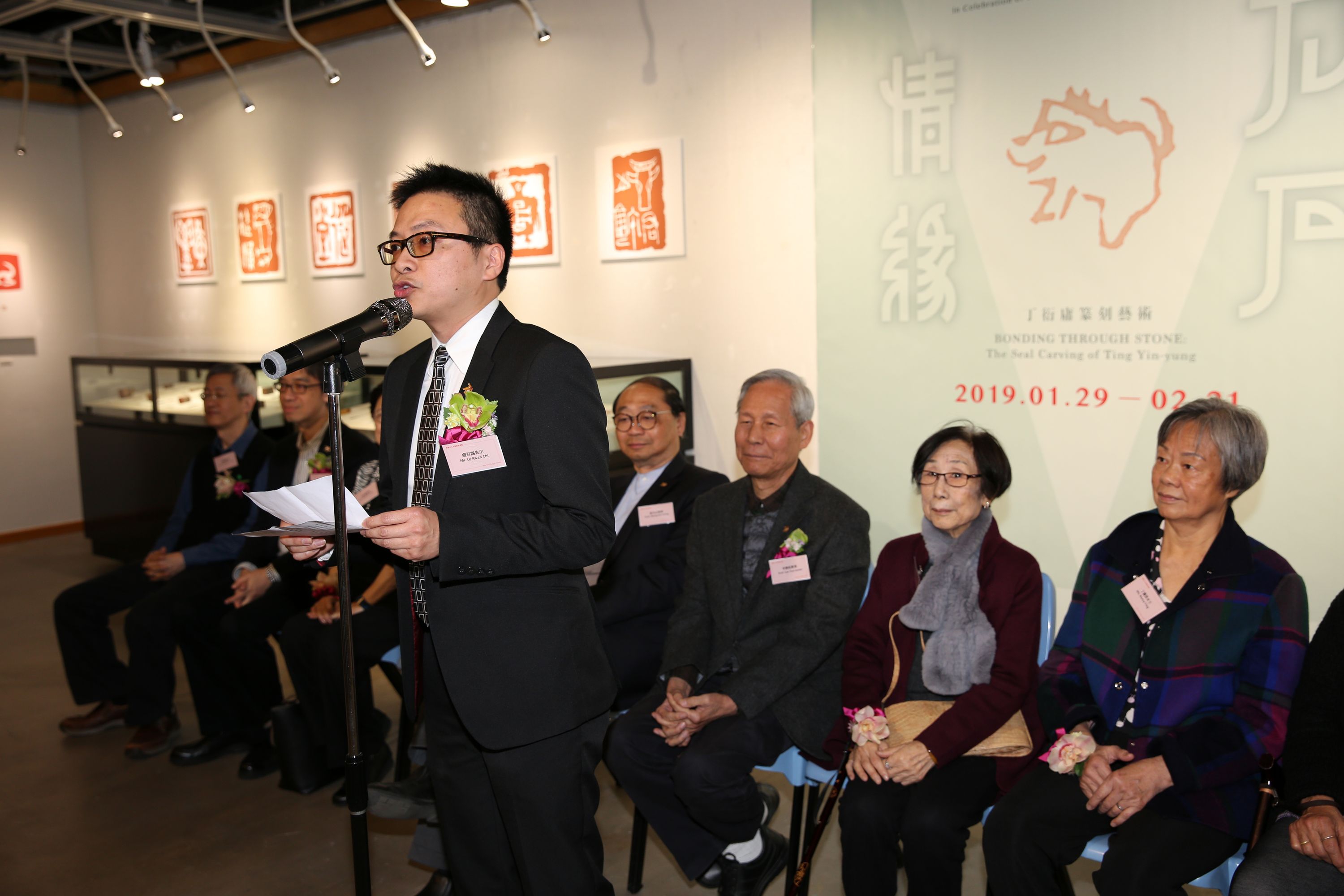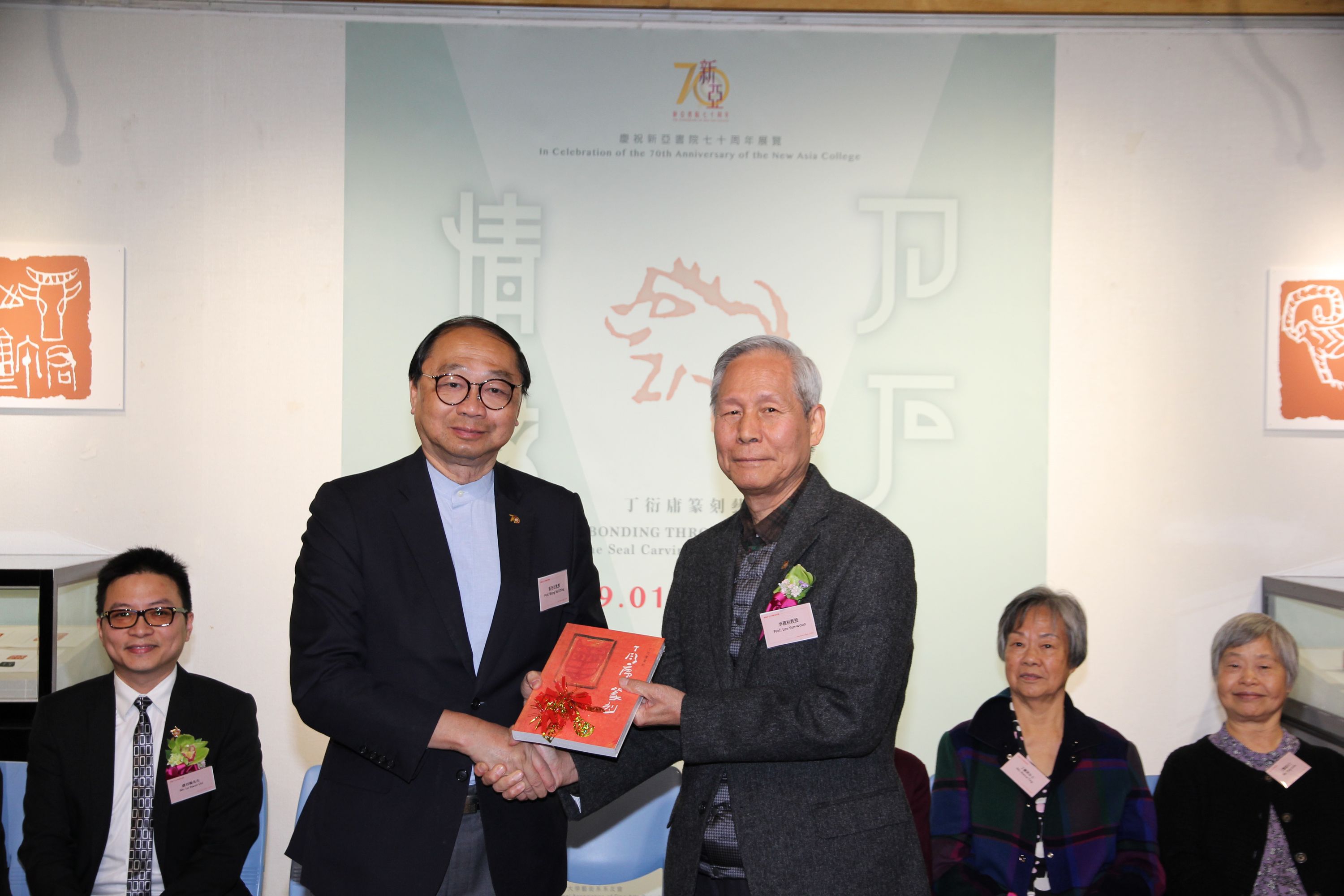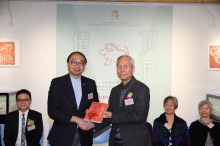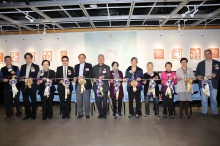CUHK
News Centre
CUHK New Asia College and Alumni Association of the Fine Arts Department Co-organise Exhibition on Ting Yin-yung’s Seal Carving to Celebrate 70th Anniversary of New Asia College
With 2018 being the 40th anniversary of Ting Yin-yung’s passing, the Alumni Association of the Fine Arts Department, The Chinese University of Hong Kong (CUHK), published Seal Carving by Ding Yan-yong in commemoration and to showcase the outcomes of a comprehensive and in-depth research into Ting’s art of seal carving. 2019 marks the 70th anniversary of New Asia College’s establishment so the Alumni Association of the Fine Arts Department and New Asia College are jointly presenting the “Bonding through Stone: The Seal Carving of Ting Yin-yung” exhibition, which is a highlight of the anniversary programme as well as the first dedicated exhibition of Ting’s seal carving, carrying great significance.
This exhibition features 120 imprints of Ting’s seals, 66 of which were for his own use or in his collection, the others having been given to his friends and students. In the exhibition, not only does every seal show us Ting’s deep understanding of Chinese art and culture, they also carry stories about the bonding between him and the recipients. Members of the public are welcome to visit the exhibition. Admission is free.
The opening ceremony for the exhibition was officiated at by the daughters of Ting Yin-yung: Ms. Ting Lo-sai, Ms. Ting Lan-sai, Ms. Ting Lai-ka and Ms. Ting Lai-ching; Prof. Lee Yun-woon, Senior College Tutor of New Asia College, former Chairman of the Department of Fine Arts, CUHK; Prof. Henry Wong, Head of New Asia College; Mr. Lo Kwan-chi, Associate Chairman of the Alumni Association of the Fine Arts Department; Prof. Mayching Kao, Honorary Fellow of CUHK, Honorary Fellow of New Asia College and Former Director of the Art Museum; Prof. Xu Xiaodong, Associate Director of the Art Museum; Prof. Frank Vigneron, Chair and Professor of the Department of Fine Arts; Prof. Harold Mok, Chair of New Asia College 70th Anniversary Sub-committee on Exhibitions and Souvenirs, and Professor of the Department of Fine Arts; Prof. Vincent Tong, Associate Professor of the Department of Fine Arts, and the Curator of the Exhibition.
Ting Yin-yung (1902-1978), courtesy names Shudan and Jibo, was more widely known as Yin-yung. Born in the Year of the Tiger and a native of Maoming, Guangdong, he went by the literary name of “Tinghu”, meaning tiger, and when he moved to Hong Kong in 1949, he began using the name “Tinghong”, meaning wild goose, as well. He studied in Japan in his early years. After returning to China, he worked as an artist and a teacher in Shanghai, Guangzhou and Chongqing. In 1956, he was invited by Ch’ien Mu (1895-1990) to join New Asia College and took part in the founding of the two-year Fine Arts Specialised Training Programme. From 1957 onwards, he taught at the Department of Fine Arts of New Asia College for 21 years. Ting was a remarkable modern artist and educator. Throughout his life, he worked towards and was accomplished in the integration of Chinese and Western art. Permeated strongly with ethnic and personal characteristics, his Chinese paintings, calligraphy and oil paintings have established his position over the past decades as one of the great art masters of our time.
In no way less than his other accomplishments, Ting’s seal carving also speaks of his personality and artistic charisma, but has not received the attention that it deserves because the artist’s seal carving is overshadowed by his own fame in painting. Fortunately, the situation has improved in recent years and his seal carving has received more attention and recognition. As Cheng Yun of the Ming dynasty said in The Meaning of Seal (Yinzhi), “Poetry is the voice of the heart and handwriting painting of the heart. They have much to do with a person’s personality. This is why those who aspire to the sublime often write with elegance and those who aspire to greatness do so with dynamism.” Rather archaic in style, Ting’s seal carving is as staunch and austere as the man himself. It was described by Jao Tsung-i as “incorporating painting into seal carving”, which can best summarise Ting’s approach to and achievement in seal carving. The “painting” that is incorporated carries multiple meanings. References drawn include Western art, Chinese calligraphy and painting, seals and other artefacts. As regards assimilation and re-engineering, emphasis is placed on the spirit and implication as well as formal features. It is apparent that his pictorial seals are the most representative examples of “incorporating painting into seal carving”, whereas the character structuring and the space of his character seals also smack strongly of paintings.
Mr. Lo Kwan-chi, Associate Chairman of the Alumni Association of the Fine Arts Department, CUHK delivers a welcoming speech.
Prof. Henry Wong, Head of New Asia College, CUHK presents a souvenir to Prof. Lee Yun-woon, Senior College Tutor of New Asia College, former Chairman of the Department of Fine Arts, CUHK.
Prof. Henry Wong, Head of New Asia College, CUHK presents a souvenir to Prof. Mayching Kao, Honorary Fellow of CUHK, Honorary Fellow of New Asia College and former Director of the Art Museum, CUHK.
Mr. Lo Kwan-chi, Associate Chairman of the Alumni Association of the Fine Arts Department, CUHK presents souvenirs to daughters of Ting Yin-yung, Ting Lo-sai, Ting Lan-sai, Ting Lai-ka and Ting Lai-ching.
(From left) The ribbon cutting guests include: Prof. Vincent Tong, Associate Professor of the Department of Fine Arts and the Curator of the Exhibition; Prof. Harold Mok, Chair of the New Asia College 70th Anniversary Sub-committee on Exhibitions and Souvenirs, and Professor of the Department of Fine Arts; Prof. Mayching Kao, Honorary Fellow of CUHK, Honorary Fellow of New Asia College and former Director of the Art Museum; Mr. Lo Kwan-chi, Associate Chairman of The Alumni Association of the Fine Arts Department; Prof. Henry Wong, Head of New Asia College; Prof. Lee Yun-woon, Senior College Tutor of New Asia College, former Chairman of the Department of Fine Arts; Ms. Ting Lo-sai; Ms. Ting Lan-sai; Ms. Ting Lai-ka; Ms. Ting Lai-ching; Prof. Xu Xiaodong, Associate Director of the Art Museum; and Prof. Frank Vigneron, Chair and Professor of the Department of Fine Arts, CUHK.

















